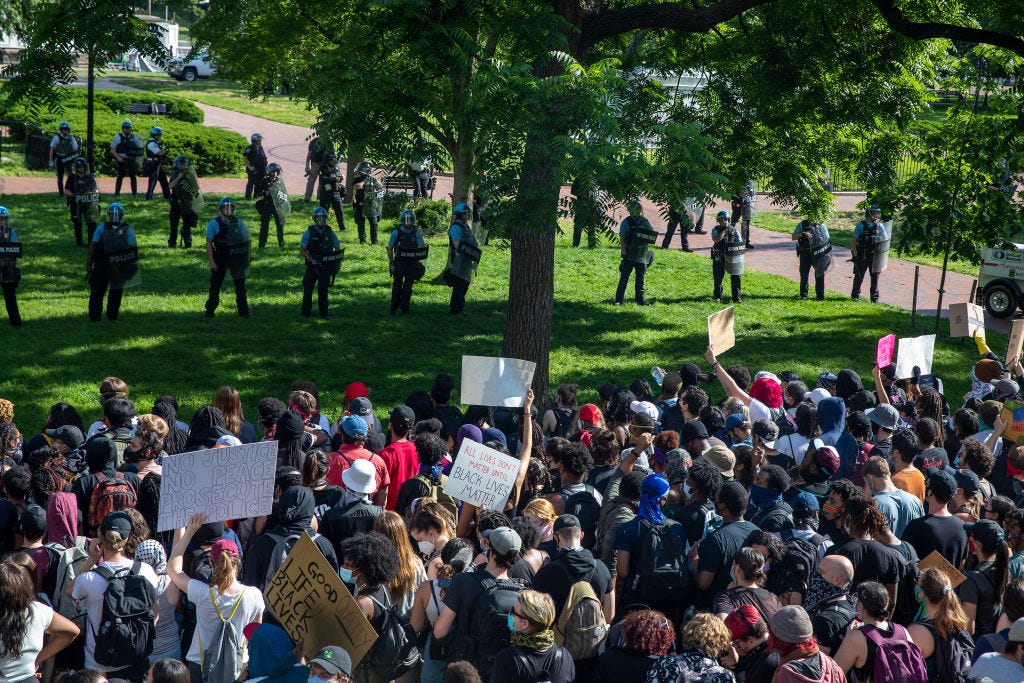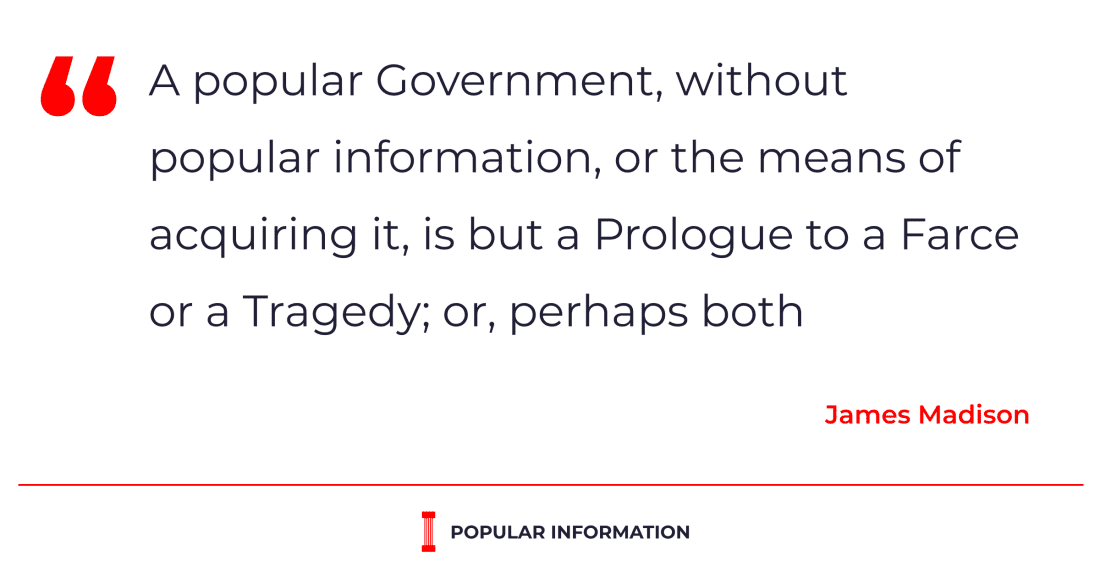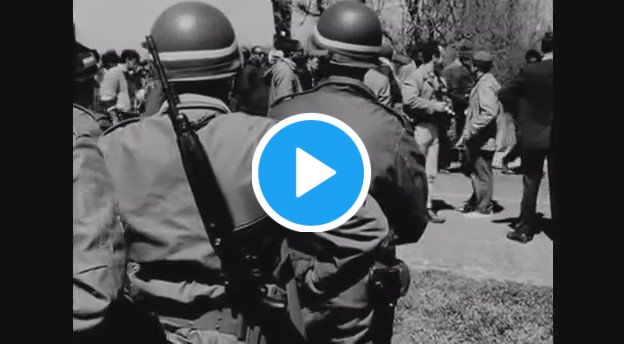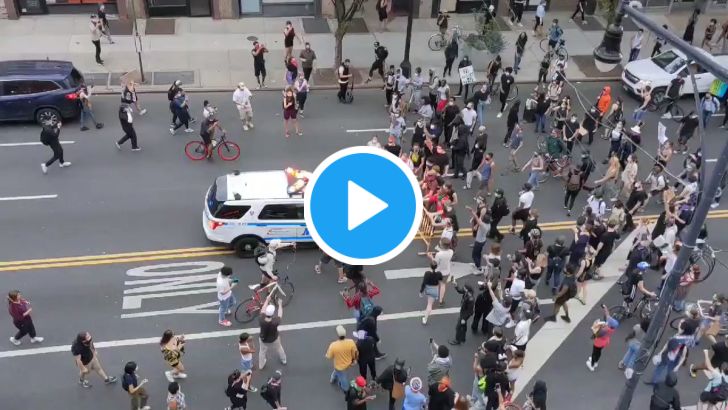 |
Protesters gather at Lafayette Square Park outside the White House on May 31, 2020 in Washington, DC. (Photo by Tasos Katopodis/Getty Images)
Over the weekend, large-scale demonstrations erupted in cities across the United States in protest of the senseless killing of George Floyd by a police officer. As some protests descended into violence and looting, several local and national officials blamed the uprising on "outside agitators." This explanation is a gross oversimplification with an ugly racial history. It has been used repeatedly to marginalize real grievances and to ignore systemic racism.
While there are certainly people attempting to exploit the unrest, there is a long history of government officials using the trope of "outside agitators" to delegitimize protests of racial injustice.
"I want to be very, very clear: The people that are doing this are not Minneapolis residents," Minneapolis Mayor Jacob Frey (D), whose city is the epicenter of the protest, said Saturday. “They are coming in largely from outside of the city, from outside of the region, to prey on everything we have built over the last several decades.”
"Every single person we arrested last night, I’m told, was from out of state," St. Paul Mayor Melvin Carter III (D) said, "What we are seeing right now is a group of people who are not from here."
Their comments were echoed by Minnesota Governor Tim Walz (D), who said, "about 20 percent are Minnesotans, and 80 percent are outside."
Arrest records tell a very different story. Investigative reporter Brandon Stahl reviewed 69 arrest records from Minneapolis-based police "for rioting, unlawful assembly and burglary-related crimes from Friday to Saturday." Of those, 56 were from Minnesota, and five were "unknown." There were just eight arrests of people from other states. In St. Paul, 12 of the 18 arrests were Minnesota residents. A city spokesman acknowledged his error and said the mayor "went with the information he had at the time."
In 1965, for example, notoriously racist Alabama sheriff, Jim Clarkwhose posse tear-gassed and clubbed civil rights protesters in Selma, blamed the situation on "outsiders" like Martin Luther King Jr. He said that the "local people" would "settle down" once King and other outsiders left.
In 1963, King broke down the perniciousness of the "outside agitator" trope in a letter he wrote while jailed in Birmingham after participating in a non-violent protest. (He was arrested because a judge issued an injunction banning all demonstrations.) King was responding to eight white members of the clergy who said segregation should be fought only in courts and objected to demonstrations "directed and led in part by outsiders."
I think I should indicate why I am here in Birmingham, since you have been influenced by the view which argues against "outsiders coming in"... I am cognizant of the interrelatedness of all communities and states. I cannot sit idly by in Atlanta and not be concerned about what happens in Birmingham. Injustice anywhere is a threat to justice everywhere. We are caught in an inescapable network of mutuality, tied in a single garment of destiny. Whatever affects one directly, affects all indirectly. Never again can we afford to live with the narrow, provincial "outside agitator" idea. Anyone who lives inside the United States can never be considered an outsider anywhere within its bounds.
King believed in non-violence, but also warned against dismissing the underlying cause of riots. "Certain conditions continue to exist in our society, which must be condemned as vigorously as we condemn riots," King said in a 1967 speech, "In the final analysis, a riot is the language of the unheard. And what is it that America has failed to hear?"
Trouble in New York
The danger of the "outside agitator" trope played out over the weekend in New York City. On Saturday night, New York City Mayor Bill DeBlasio (D) claimed that many protesters in New York City were "coming in from outside."
He then went on to defend the actions of the police who drove through a crowd of protesters.
"It's inappropriate for protesters to surround a police vehicle and threaten police officers. That's wrong on its face, and that hasn't happened in the history of protest in NYC," DeBlasio said, "Officers have to get out of the situation. It's a very, very tense situation and imagine what it'd be like if you're just trying to do your job and you see hundreds of people converging upon you. I'm not gonna blame officers who are trying to deal with an absolutely impossible situation."
DeBlasio's decision to blame the protests on outsiders and his decision to defend police officers driving through protesters are related. It's easier to defend violent action by the police directed at outsiders who came to the city to create trouble. It's much harder to defend the potentially deadly use of force against your own constituents.
In another widely-circulated video, an NYPD police officer pulls down the mask of a protester and pepper sprays his face.
On Sunday, DeBlasio praised the police on "tremendous restraint overall." He "could not immediately provide information on where the outside agitators are coming from."
Trump casually threatens to deploy the military to kill Americans
The "outside agitator" trope was also aggressively embraced by Trump and his administration. In one tweet, Trump described the protestors as opponents of "good, hardworking Minneapolis residents who want peace."
Attorney General Bill Barr, without citing any evidence, echoed Trump, claiming that "outside radicals and agitators are exploiting the situation to pursue their own separate and violent agenda."
Neither Trump nor Barr acknowledged that the 80% figured cited by Waltz was debunked. Instead, Trump warned that "Crossing State lines to incite violence is a FEDERAL CRIME." That was followed by a threat to use "the unlimited power of our Military" against Americans.
Trump had particular disdain for the protesters who showed up at the White House in Washington, DC. He not only claimed they were outsiders but also "professionally managed" with little regard for the "the memory of George Floyd." Trump praised the Secret Service for coming down "hard" on anyone who got "too frisky." He said the officers were prepared to use "vicious dogs" and the "most ominous weapons I have ever seen" against the crowd.
It's a vivid example of how the outside agitator trope creates a destructive cycle. The trope is used by Trump, and others, to justify excessive use of force by law enforcement. But excessive use of force by law enforcement is what catalyzed the demonstrations in the first place. The use of excessive force in response to the unrest will likely make things worse.
Thanks for reading!
 |








